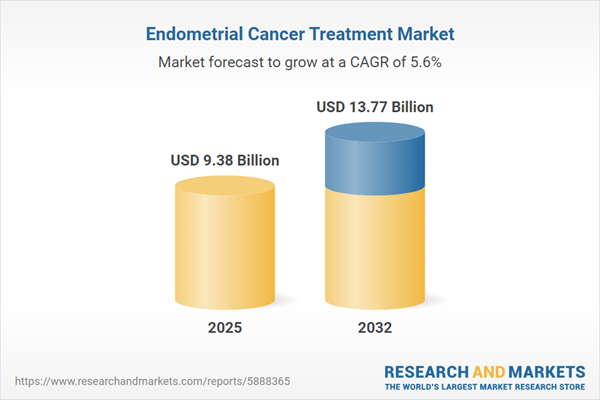Speak directly to the analyst to clarify any post sales queries you may have.
The endometrial cancer treatment market is undergoing a major transformation as healthcare organizations adapt strategies to navigate clinical advances, regulatory changes, and new care delivery models. Adaptive decision-making and agile operational strategies are now essential for senior leaders to remain competitive amidst these sector-wide shifts.
Market Snapshot: Endometrial Cancer Treatment Market Size and Growth
The global endometrial cancer treatment market is projected to increase from USD 8.87 billion in 2024 to USD 9.38 billion in 2025, ultimately reaching USD 13.77 billion by 2032, reflecting a compound annual growth rate (CAGR) of 5.64%. This robust expansion is propelled by the widespread integration of advanced diagnostic technologies, breakthroughs in precision medicine, and greater availability of immunotherapies and new targeted approaches. Healthcare organizations are also realigning their strategies to adapt to evolving regulations and shifting reimbursement models, enabling a more competitive posture in the marketplace.
Scope & Segmentation: Strategic Executive Overview
This report equips senior executives with practical insights to streamline initiatives, allocate resources efficiently, and make timely, informed strategic decisions across the evolving endometrial cancer treatment landscape. Leaders can expect detailed analysis across crucial market dimensions:
- Treatment Types: Covers chemotherapy, hormone-based therapies, immunotherapy, advanced combination regimens, radiation therapy, surgical interventions, and targeted drug options. Each approach influences care pathways, resource management, and operational model development.
- Drug Classes: Focuses on antiangiogenic agents, platinum-based variants, taxanes, aromatase inhibitors, progestins, immune checkpoint and pathway inhibitors. These classes support strategies to address resistance and complement advancements in clinical research.
- Line of Therapy: Examines strategies from first-line to late-line therapy, allowing organizations to customize approaches based on disease stage and patient treatment response.
- Mode of Administration: Highlights logistical and operational implications of both oral and intravenous delivery methods, from staffing to patient adherence tracking.
- Administration Setting: Considers inpatient, outpatient, and ambulatory models, guiding the choice of optimal care structures and workflow management for diverse patient segments.
- Geographic Coverage: Provides regional analysis of the Americas, Europe, Middle East, Africa, and Asia-Pacific, emphasizing regulatory frameworks, commercial practices, and region-specific drivers and challenges.
- Technology Platforms: Explores the role of imaging, molecular profiling, biomarker testing, and next-generation sequencing within emerging personalized treatment protocols and diagnostic enhancements.
- Leading Companies Tracked: Profiles industry leaders, including Merck & Co., GlaxoSmithKline, Eisai, Bristol-Myers Squibb, Roche, AstraZeneca, Pfizer, Novartis, Johnson & Johnson, and Eli Lilly, to provide comparative insights into innovation focus and strategic positioning.
This comprehensive segmentation analysis supports leaders in strengthening operational agility, promoting adoption of innovative technologies, and responding efficiently to distinct regional market demands.
Key Takeaways: Strategic Insights for Decision-Makers
- Precision medicine and immunotherapy developments are prompting organizations to update patient-centered service models and workflows for improved care delivery.
- Modern diagnostic solutions play a critical role in refining patient stratification and supporting more tailored treatment planning across diverse demographic groups.
- Effective partnership among oncology teams, including oncologists, pathologists, and surgeons, enhances care coordination and resource allocation, especially for complex patient cases.
- Broadening therapeutic offerings helps healthcare organizations address rising expectations from both patients and payers for outcome-focused, high-quality care.
- Ongoing monitoring of new technology integration and payer landscape evolution is vital for maintaining adaptability amid continuous regulatory, reimbursement, and operational changes.
- Building robust strategic partnerships accelerates regulatory approvals and market access, positioning organizations to adapt to rapid industry shifts.
Tariff Impact: Navigating US Trade Policy and Supply Chain Adjustments
Forthcoming US tariffs on pharmaceutical imports in 2025 are reshaping procurement and supply chain management in the endometrial cancer treatment sector. Organizations are responding by expanding supplier networks and strengthening contingency plans to offset potential disruptions. Active collaboration between manufacturers, purchasing groups, and regulatory stakeholders remains essential to ensure steady patient access and consistent supply throughout anticipated policy changes.
Methodology & Data Sources
This analysis integrates data from peer-reviewed research, clinical trials, recent regulatory submissions, and expert panel commentary. Insights were further validated through workshops with multidisciplinary teams, ensuring clarity, relevance, and usability for executive decision-making.
Why This Report Matters: Leadership Outcomes
- Prepares executives to anticipate changing regional dynamics, regulatory requirements, and commercialization strategies for enhanced risk management and long-range planning.
- Delivers actionable intelligence on evolving payer influences, optimized market access pathways, and compliance considerations to support more strategic allocation of capital and resources.
- Connects leadership teams with the latest industry insights on clinical advances and technology integration, informing operational excellence and market responsiveness.
Conclusion
By leveraging the data and insights in this report, senior decision-makers are better equipped to guide their organizations through transformation, foster adaptive business strategies, and maintain resilience as the endometrial cancer treatment market evolves.
Additional Product Information:
- Purchase of this report includes 1 year online access with quarterly updates.
- This report can be updated on request. Please contact our Customer Experience team using the Ask a Question widget on our website.
Table of Contents
3. Executive Summary
4. Market Overview
7. Cumulative Impact of Artificial Intelligence 2025
Companies Mentioned
The companies profiled in this Endometrial Cancer Treatment market report include:- Merck & Co., Inc.
- GlaxoSmithKline plc
- Eisai Co., Ltd.
- Bristol-Myers Squibb Company
- F. Hoffmann-La Roche Ltd
- AstraZeneca PLC
- Pfizer Inc.
- Novartis AG
- Johnson & Johnson
- Eli Lilly and Company
Table Information
| Report Attribute | Details |
|---|---|
| No. of Pages | 194 |
| Published | October 2025 |
| Forecast Period | 2025 - 2032 |
| Estimated Market Value ( USD | $ 9.38 Billion |
| Forecasted Market Value ( USD | $ 13.77 Billion |
| Compound Annual Growth Rate | 5.6% |
| Regions Covered | Global |
| No. of Companies Mentioned | 11 |









